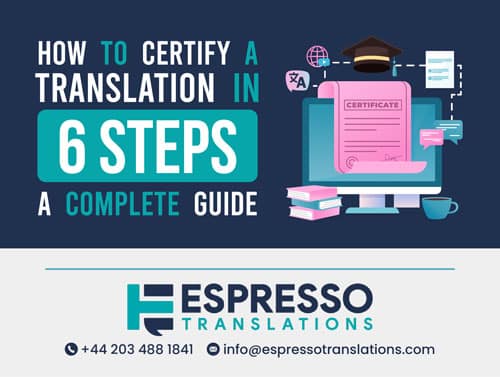The first step is to gain an understanding of what the recipient organization requires in the country where the translation will be used. Once you have this information, hire a professional translator to translate your document into a different language and certify the translation. The translator could be a freelancer with experience doing certified translations, or you could inquire at a translation agency with a good reputation.
How do you certify a translation document?
The person translating your documents should have a solid amount of experience and a track record of accuracy, because just one small mistake or inconsistency could cause legal problems or render your documents invalid. You need to find a professional translator who has more than great linguistic proficiency: they should have nearly native familiarity with the target language and a good understanding of the surrounding culture. They should also have in-depth knowledge of the subject of the document (law, patents immigration, etc.).
To avoid unwanted delays or extra expenses, you must be sure to meet the official requirements of the government agency or organization that is going to use the translation. Requirements can be different in different countries, so be sure to check the specific requirements the recipient organization has. A certified translation agency can also provide advice on the official requirements for the country or organization in question.
In the United States, for instance, special qualifications are not necessary in order to certify a translation. Normally a second translator will certify a translation, as self-certification is not ideal. In some other countries, a public official must witness the person signing the certification statement, or the translation may not be officially recognized.
As you might expect, the cost of a certified translation is generally more than that of a standard translation, because the certifying translator is taking legal responsibility for the correctness and precision of their translation. When you need quality translations you can trust, Espresso Translations can help.
1. Understand the need for certified translations
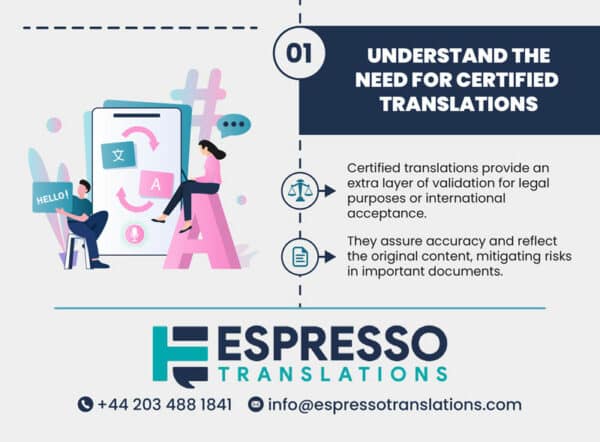
Certified translations may be required for legal purposes or to ensure international acceptance by government agencies, educational institutions, embassy officials, or public entities. These places require certified translations because, if certain terms are misinterpreted, the legality of the document could be compromised, or you might even suffer a financial loss. A certified translation involves an extra validation step that assures the receiving party that your document has been translated accurately and that it faithfully reflects the content of the original document.
For instance, you might be submitting papers to another country for immigration purposes. As long as the translator can certify the accuracy of the translation and take responsibility for its content, your chances are better that the immigration officer reviewing your paperwork will approve your application. Approval is at the discretion of the immigration officer, so a certified translation will make success more likely.
Many entities in foreign countries also require certified translations, because the certification means that the translator must review the translation with great care to ensure perfect accuracy.
2. Choose the right certified translation service
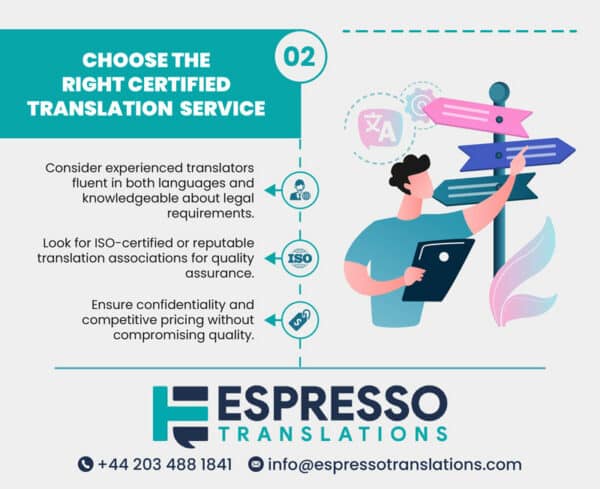
When you are deciding on a certified translation service, you’ll need to consider the following four aspects of the translation:
- Quality: The translation service you use must have experienced translators fluent in the target language as well as the source language, and this goes beyond vocabulary to proper grammar and an understanding of idioms. For best results, use a translator or translation agency with ISO certification or membership in a translation association such as the American Translators Association (ATA), the Association of Translation Companies (ATC), or the Institute of Translation & Interpreting (ITI).
- Certification: The translator or agency you deal with should be clear on what you need, and they should be familiar with the official and legal requirements for translations in the target country. For good measure, you can ask to see an example of a certified translation and then check with the recipient entity that it will meet all requirements.
- Confidentiality: Security and privacy are especially important issues these days. The sensitive personal information in your translated document must be protected at every step, and the translator you hire should be well aware of confidentiality concerns.
- Cost: Quality, certification, and confidentiality all have implications for the ultimate price to be paid. Without accepting compromises in the first three aspects, try to hire a translator or agency that charges a competitive price. Shopping around should yield someone qualified to translate your important documents who charges a reasonable rate.
3. Ask for a quote and delivery time to certify a translation
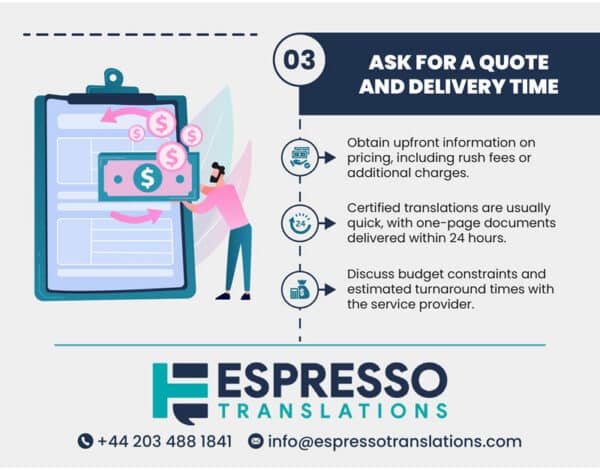
Different freelance translators and translation companies can charge significantly different rates. Ask up front for complete information on possible rush fees, mailing costs, or surcharges for document formatting. Of course, if your documents are highly complex, involve special knowledge, or require a specific language combination that isn’t commonly requested, this will also influence the bottom line.
If the certified translation you need does not need to be sworn, the turnaround time may be fairly short. Often a one-page document can be translated and certified within 24 hours. If you have a specific deadline for submitting the translation, perhaps when applying for a visa or going through procedures with government entities, this could affect the cost of a longer document.
Remember that it is okay to talk to your translation company or translator about the limits on your budget. Ask if they can offer more affordable solutions or flexible payment terms. Also ask them how they calculate the delivery time for your project, and what happens if there is an unexpected delay.
Start a dialog with Espresso Translations by asking for a free quote, and your questions will be answered.
4. Submit an electronic copy of your documents to your translation provider
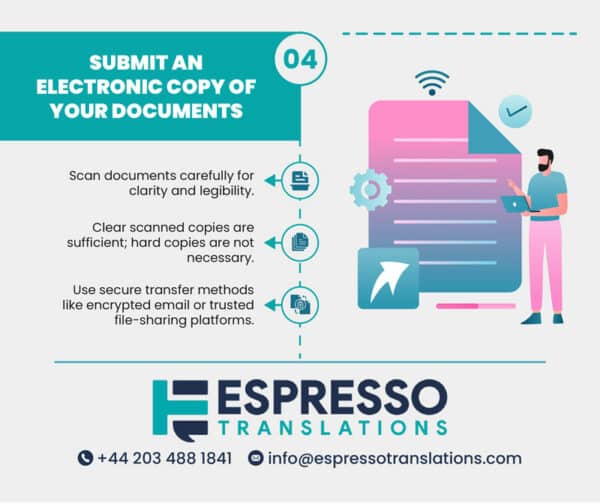
If the document you need to get translated is not already in electronic form, you will need to scan it. When scanning, take care that each page is clear and easy to read, with no parts cut off. The translator or translation company might refuse to certify their translation when they are not able to be certain that they are creating a completely accurate translation of the original. When you can make a clearly legible scan, you will not need to deliver a hard copy in order for them to translate the document.
Here again, you must keep security in mind. Try to use a secure transfer method like encrypted email or a familiar file sharing platform like WeTransfer, OneDrive or Google Drive to protect yourself from malicious third parties trying to intercept your documents.
5. Get your certified or notarized translation
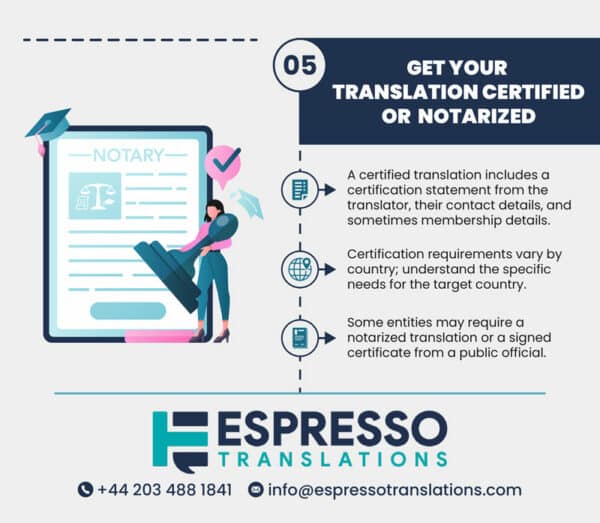
Your certified translation should include the translator’s attestation that they personally translated the document, and it should include a signed statement such as “this is a true and accurate translation of the original” to affirm the quality of the translation. The certification should also contain the translator’s name and contact information.
If the certificate mentions that the translator is a member of a translation association such as the ATA in the US or the ATC in the UK, that is a nice assurance, but not one that is strictly necessary. The key point is to get a certified translation stating that the quality of your foreign language document is recognized and accepted by international entities.
6. Review and verify the certified translation
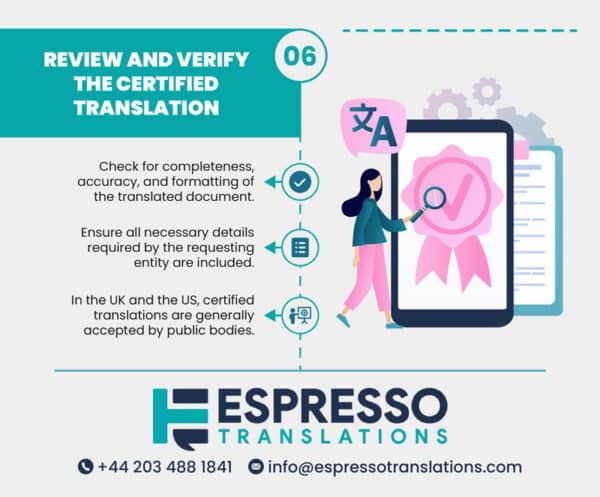
Taking a few minutes to make sure the translation you received is complete and accurate is well worth doing. Double-check how names are spelled, and look over address information and birth dates. Finally, glance through the original and the translation side by side to scan for possible omissions (you should not find any) and compare the formatting.
In the US and the UK, a certified translation will normally be accepted by the USCIS, the Passport Office, the Foreign and Commonwealth Office, and other foreign entities. Still, you should make sure that the certification meets all the requirements for the level of certification desired by the receiving entity you are dealing with.
Check that the notary public included their seal and stamp if the receiving entity also requested a notarized translation.
Unlike the United States, some civil law countries will ask for a signed certificate from a public official in addition to the certified translation. You should have checked the specific requirements before you submitted your documents for translation.
FAQ
Can anyone certify a translation in the United States?
In the United States, a certified translation can be done by any skilled translator with the appropriate fluency in the language pair involved. A translator does not need to possess any specific credentials. It’s best, however, when the translation gets certified by a second translator who can verify the first translator’s accuracy.
What is a certified translation certificate?
A translation certificate is an official document confirming that the translation accurately reflects the original document’s content. The certificate must include the translator’s name and contact information (postal address, email address, and phone number). The certification statement must specify that the translated document is a true and accurate translation of the original document and that it was a human translation done by a person fluent in both languages. Finally, the certificate must bear the certifying translator’s signature and the certification date.
Can a certified translation be done online?
These days, certified translations are commonly performed online and even attain official approval online. Espresso Translations can help you with the process, so get a quote today.
Who can certify translations?
Any appropriately skilled language services professional or certified linguist can certify that a translation is complete and accurate. A stringent certification process is followed that validates each translation for correctness and completeness. Most translation agencies can also provide certificates of accuracy for translations done on their behalf.
How do you know if a translator is certified?
The United States has no official requirements for a translator to be certified. Certification by the American Translators Association (ATA) is, however, widely accepted as a credential for a translator. Translators must pass an ATA exam in order to be certified. The United Nations Translation Accreditation credential is issued by the American Society of Travel Advisers/United States of America (ASTA-USA) upon passing a Language Competitive Examination. Another one is the Certified Translation Professional (CTP) credential issued by Global Translation Institute (GTI). An ATA-certified translator, or a translator with the ASTA-USA or CTP credentials, should be a reliable provider of translation services.
Beyond the US, many countries have their own standards and credentials for translators.
Where can I officially translate a document?
As mentioned above, the United States has no official credentials for translators. If a government office asks you to provide a certified translation for official purposes, however, a certified translator is your best bet for language proficiency and translation accuracy. Certified linguists have gone through extensive training and testing to prove their skill in translating from one language to another.
Do translations need to be certified for USCIS?
The United States Customs and Immigration Service (USCIS) will often require certified translation services in many cases, such as international legal disputes, academic applications, and immigration processes.
Can I use Google Translate for certified translations?
We do not recommend you use Google Translate, AI, or other machine translation tools, as they would not be suitable for a certified translation. The accuracy and fluency of such tools, while they can give you the general idea of what the original says, don’t measure up to professional standards. Only human translations will be accepted by public entities and institutions.
Can I certify my own translation?
Self-certification is not a good idea. Legal documents and papers for legal proceedings certainly must be translated by a professional. And for any type of official purposes, getting a certified translation of your documents makes it much more likely that your document will be accepted.

